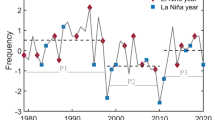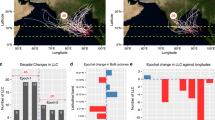Abstract
A recent study showed that the global average latitude where tropical cyclones achieve their lifetime-maximum intensity has been migrating poleward at a rate of about one-half degree of latitude per decade over the last 30 years in each hemisphere. However, it does not answer a critical question: is the poleward migration of tropical cyclone lifetime-maximum intensity associated with a poleward migration of tropical cyclone genesis? In this study we will examine this question. First we analyze changes in the environmental variables associated with tropical cyclone genesis, namely entropy deficit, potential intensity, vertical wind shear, vorticity, skin temperature and specific humidity at 500 hPa in reanalysis datasets between 1980 and 2013. Then, a selection of these variables is combined into two tropical cyclone genesis indices that empirically relate tropical cyclone genesis to large-scale variables. We find a shift toward greater (smaller) average potential number of genesis at higher (lower) latitudes over most regions of the Pacific Ocean, which is consistent with a migration of tropical cyclone genesis towards higher latitudes. We then examine the global best track archive and find coherent and significant poleward shifts in mean genesis position over the Pacific Ocean basins.





Similar content being viewed by others
References
Barnston AG, Chelliah M, Goldenberg SB (1997) Documentation of a highly ENSO-related SST region in the equatorial Pacific. Atmos Ocean 35:367–383
Bister M, Emanuel KA (1998) Dissipative heating and hurricane intensity. Meteorol Atmos Phys 65:223–240
Bruyère CL, Holland GJ, Towler E (2012) Investigating the use of a genesis potential index for tropical cyclones in the North Atlantic Basin. J Clim 25:8611–8626
Bye J, Keay K (2008) A new hurricane index for the Caribbean. Interscience 33:556–560
Camargo SJ, Sobel AH, Barnston AG, Klotzbach PJ (2010) The influence of natural climate variability, and seasonal forecasts of tropical cyclone activity. In: Chan JCL, Kepert JD (eds) Global perspectives on tropical cyclones, from science to mitigation, 2nd edition, World Scientific Series on Earth System Science in Asia, vol 4, Chap 11, pp 325–360. ISBN 978-981-4293-47-1
Camargo SJ, Tippett MK, Sobel AH, Vecchi GA, Zhao M (2014) Testing the performance of tropical cyclone genesis indices in future climates using the HIRAM model. J Clim 27:9171–9196. doi:10.1175/JCLI-D-13-00505.1
Colbert AJ, Soden BJ, Vecchi GA, Kirtman BP (2013) The impact of anthropogenic climate change on North Atlantic tropical cyclone tracks. J Clim 26:4088–4095
Dee DP, Uppala SM, Simmons AJ, Berrisford P, Poli P, Kobayashi S, Andrae U, Balmaseda M A, Balsamo G, Bauer P, Bechtold P, Beljaars ACM, van de Berg L, Bidlot J, Bormann N, Delsol C, Dragani R, Fuentes M, Geer AJ, Haimberger L, Healy SB, Hersbach H, Hólm EV, Isaksen L, Kållberg P, Köhler M, Matricardi M, McNally AP, Monge-Sanz BM, Morcrette J-J, Park B-K, Peubey C, de Rosnay P, Tavolato C, Thépaut J-N, Vitart F (2011) The ERA-Interim reanalysis: configuration and performance of the data assimilation system. Q J R Meteorol Soc 137:553–597. doi:10.1002/qj.828
DeMaria M, Knaff JA, Conell BH (2001) A tropical cyclone genesis parameter for the tropical Atlantic. Weather Forecast 16:219–233
Ebita A, Kobayashi S, Ota Y, Moriya M, Kumabe R, Onogi K, Harada Y, Yasui S, Miyaoka K, Takahashi K, Kamahori H, Kobayashi C, Endo H, Soma M, Oikawa Y, Ishimizu T (2011) The Japanese 55-year reanalysis “JRA-55”: an interim report. Sci Online Lett Atmos 7:149–152. doi:10.2151/sola.2011-038
Emanuel KA (1988) The maximum intensity of hurricanes. J Atmos Sci 45:1143–1155. doi:10.1175/1520-0469(1988)045<1143:TMIOH>2.0.CO;2
Emanuel K (2008) The Hurricane-climate connection. Bull Amer Meteorol Soc 89:ES10–ES20
Emanuel K (2010) Tropical cyclone activity downscaled from NOAA-CIRES reanalysis, 1908–1958. J Adv Model Earth Syst 2. doi:10.3894/JAMES.2010.2.1
Emanuel KA, Nolan DS (2004) Tropical cyclone activity and the global climate system. Preprints, 26th Conf. on Hurricanes and Tropical Meteorology, Miami, FL, Amer. Meteor. Soc., 10 A.2. http://ams.confex.com/ams/pdfpapers/75463.pdf
Gray WM (1979) Hurricanes: their formation, structure and likely role in the tropical circulation. Meteorol Trop Oceans, D. B. Shaw, Ed., Royal Meteorological Society, 155–218
Holland GJ, Bruyère CL (2014) Recent intense hurricane response to global climate change. Clim Dyn 42:617–627
Kamahori H, Yamazaki N, Mannoji N, Takahashi K (2006) Variability in intense tropical cyclone days in the western North Pacific. Sci Online Lett Atmos 2:104–107
Knapp KR, Kruk MC (2010) Quantifying interagency differences in tropical cyclone best-track wind speed estimates. Mon Weather Rev 138(4):1459–1473
Knapp KR, Kruk MC, Levinson DH, Diamond HJ, Neumann CJ (2010) The international best track archive for climate Stewardship (IBTrACS). Bull Am Meteorol Soc 91:363–376
Kossin JP (2015) Validating atmospheric reanalysis data using tropical cyclones as thermometers. Bull Amer Meteorol Soc 96:1089–1096
Kossin JP, Olander TL, Knapp KR (2013) Trend analysis with a new global record of tropical cyclone intensity. J Clim 26:9960–9976
Kossin JP, Emanuel KA, Vecchi GA (2014) The poleward migration of the location of tropical cyclone maximum intensity. Nature 509:349–352. doi:10.1038/nature13278
Kossin JP, Emanuel KA, Camargo SJ (2016) Past and projected changes in western North Pacific tropical cyclone exposure. J Clim 29:5725–5739
Kotal SD, Kundu PK, Roy Bhowmik SK (2009) Analysis of cyclogenesis parameter for developing and nondeveloping low-pressure systems over the Indian Sea. Nat Hazards 50(2):389–402. doi:10.1007/s11069-009-9348-5
Lander MA (2008) A comparison of typhoon best-TRACK data in the western North Pacific: Irreconcilable differences. 28th Conf. on Hurricanes and Tropical Meteorology, Orlando, FL, Am. Meteorol. Soc., 4B2. http://ams.confex.com/ams/28Hurricanes/techprogram/paper_137395.htm
Lucas C, Timbal B, Nguyen H (2014) The expanding tropics: a critical assessment of the observational and modeling studies. WIREs. Clim Change 5:89–112
Menkes CE, Lengaigne M, Marchesiello P, Jourdain NC, Vincent EM, Lefevre J, Chauvin F, Royer JF (2012) Comparison of tropical cyclogenesis indices on seasonal to interannual timescales. Clim Dyn 38:301–321. doi:10.1007/s00382-011-1126-x
Murakami H, Wang B (2010) Future change of North Atlantic tropical cyclone tracks: projection by a 20-km-mesh global atmospheric model. J Clim 23:2699–2721
Nguyen H, Evans A, Lucas C, Smith I, Timbal B (2013) The Hadley circulation in reanalyses: climatology, variability, and change. J Clim 26:3357–3376
Reichler T, Kim J (2008) Uncertainities in the climate mean state of global observations, reanalyses, and the GFDL climate model. J Geophys Res 113:D05106. doi:10.1029/2007JD009278
Rienecker MM, Suarez MJ, Gelaro R, Todling R, Bacmeister J, Liu E, Bosilovich MG, Schubert SD, Takacs L, Kim G-K, Bloom S, Chen J, Collins D, Conaty A, da Silva A, Gu W, Joiner J, Koster RD, Lucchesi R, Molod A, Owens T, Pawson S, Pegion P, Redder CR, Reichle R, Robertson FR, Ruddick AG, Sienkiewicz M, Woollen J (2011) MERRA: NASA’s modern-era retrospective analysis for research and applications. J Clim 24(14):3624–3648
Royer J-F, Chauvin F, Timbal B, Araspin P, Grimal D (1998) A GCM study of the impact of greenhouse gas increase on the frequency of occurrence of tropical cyclone. Clim Change 38:307–343
Sall SM, Sauvageot H, Gaye AT, Viltard A, de Felice P (2006) A cyclogenesis index for tropical Atlantic off the African coasts. Atmos Res 79:123–147
Tang B, Camargo SJ (2014) Environmental control of tropical cyclones in CMIP5: a ventilation perspective. J Adv Model Earth Syst. doi:10.1002/2013MS000294
Tang B, Emanuel K (2012) Sensitivity of tropical cyclone intensity to ventilation in an axisymmetric model. J Atmos Sci 69:2394–2413
Taylor KE, Stouffer RJ, Meehl GA (2012) An overview of CMIP5 and the experiment design. Bull Am Meteorol Soc 93:485–498. doi:10.1175/BAMS-D-11-00094.1
Thorne PW, Vose RS (2010) Reanalyses suitable for characterizing long-term trends. Bull Meteorol Soc 91:353–361
Tippett MK, Camargo SJ, Sobel AH (2011) A Poisson regression index for tropical cyclone genesis and the role of large-scale vorticity in genesis. J Clim 24:2335–2357. doi:10.1175/2010JCLI3811.1
Acknowledgements
The authors would like to thank Dr. Kossin and Dr. Vimont for their input and guidance. They also would like to thank Dr. Emanuel for providing the genesis potential index datasets. The authors would like to thank an anonymous reviewer for its very insightful comments. Finally, we would like to thank Erin Thomas for the English corrections. The reanalysis datasets were acquired from the Climate Data Guide and the Research Data Archive, developed by the University Corporation for Atmospheric Research (UCAR) which, includes the National Center for Atmospheric Research (NCAR). The reanalysis MERRA was acquired thanks to the dissemination of the data by the Global Modeling Assimilation Office (GMAO) and the Goddard Earth Sciences (GES) Data and Information Services Center (DISC). ERA-Interim data was obtained from the European Center for Medium-range Weather Forecast (ECMWF) data server. SJC acknowledges support from NOAA Grant NA11OAR4310093.
Author information
Authors and Affiliations
Corresponding author
Rights and permissions
About this article
Cite this article
Daloz, A.S., Camargo, S.J. Is the poleward migration of tropical cyclone maximum intensity associated with a poleward migration of tropical cyclone genesis?. Clim Dyn 50, 705–715 (2018). https://doi.org/10.1007/s00382-017-3636-7
Received:
Accepted:
Published:
Issue Date:
DOI: https://doi.org/10.1007/s00382-017-3636-7




